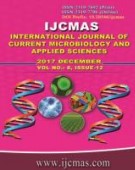


 National Academy of Agricultural Sciences (NAAS)
National Academy of Agricultural Sciences (NAAS)

|
PRINT ISSN : 2319-7692
Online ISSN : 2319-7706 Issues : 12 per year Publisher : Excellent Publishers Email : editorijcmas@gmail.com / submit@ijcmas.com Editor-in-chief: Dr.M.Prakash Index Copernicus ICV 2018: 95.39 NAAS RATING 2020: 5.38 |
A field experiment was conducted at Kanpur, Uttar Pradesh during two Kharif seasons of 2012 and 2013 to assess the relative productivity and profitability of pearlmillet (Pennisetum glaucum L.) as influenced by different low cost water harvesting techniques. The soil of the experimental field was sandy loam in texture with average fertility. Water harvesting techniques tested in the experiment were compartmental bunding, deep ploughing, raised and sunken bed, inter row water harvesting, inter-paired row water harvesting, scooping and flat sowing as control. The result revealed that different rain water harvesting techniques showed significant response over control in respect to yield, root development and monetary return. Among different water harvesting techniques, inter-paired row water harvesting (IPRWH) produced highest seed yield of 20.50 and 21.90 q ha-1 fetching Rs. 17512 and 20557 ha-1 which exhibited maximum B:C ratio of 1.04 and 1.22 during 2012 and 2013, respectively.
 |
 |
 |
 |
 |